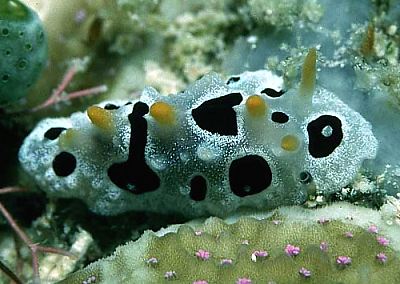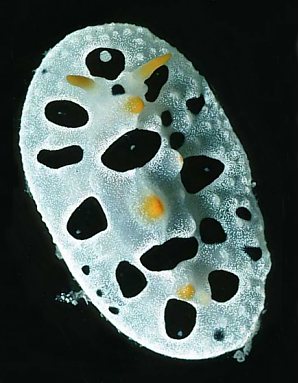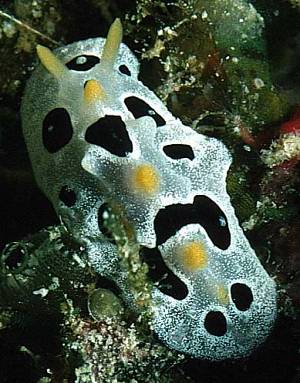Re: Fryeria marindica from the Phillipines
June 30, 2002
From: Bernard Picton

Hi Bill,
I don't think the animal from the Philippines is Fryeria marindica. I was about to write and say it was Phyllidia babai, as that is what I was calling animals looking like this, but then I reread Brunckhorst and think I was wrong in my identifications. I've attached scans of two animals, one from Bali and one from Hoga, SW Sulawesi. To me they are intermediate between Phyllidia babai and Phyllidia willani. The black markings have a quite regular basic plan - a single central one at the front, then a pair of rounded marks, then a central mark flanked by two others, (which may join with it to form a continuous band in the Phillipines material?), then two lateral ones again, then another three (or band - see Hoga specimen) then two. There is a scattering of white spots which get denser along the edges of the black markings. There are three tall, orange-tipped tubercles down the middle of the back.
Bob Bolland has an animal like a larger version of this on his website as Phyllidia babai. I wonder what you make of it?
Upper/Lower Right: Hoga, Sulawesi, Indonesia Sept 1997 - 20mm
Lower left: Bali, Indonesia, April 1989 - 25mm
Bernard
bernard.picton.um@nics.gov.uk


Thanks Bernard,
I can certainly see the pattern of colours and tubercles you mention, and Bob Bolland's animal also fits. I have difficulty differentiating P. babai from P. willani. My feelings on the animal from the Philippines was partially based on the distinctive bluish tinge to the mantle. As far as I know neither P. babai nor P. willani have been reported to have a blue colour phase, they are always covered with a heavy dusting of white specks on a translucent background.
Certainly the distinctive tubercle pattern in the middle of the back that you describe is unlike either species. I think I will put then on a separate page as Phyllidia cf. babai, at least temporarily, until we get some more information on them.
Cheers,
Bill Rudman
Related messages
-
Record of Fryeria marindica from the Phillipines
From: Fredy Brauchli, June 22, 2002
